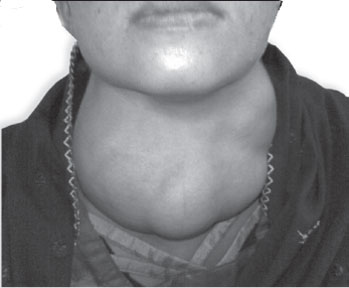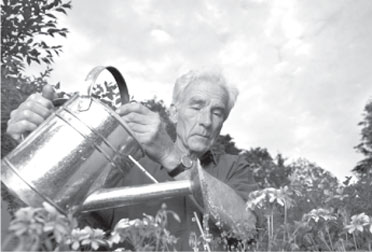|

Take care of your thyroid
by Nilma DOLE
One of the largest endocrine glands in the body, the thyroid gland is
a butterfly-shaped gland situated at the front of the neck, below the
voice box. Derived from the Greek word for “shield”, this is attributed
to its shape.
 The
thyroid gland is controlled by thyroid-stimulating Hormone (TSH)
produced by the pituitary and Thyrotropin-Releasing Hormone (TRH)
produced by the hypothalamus. The thyroid gland gets its name from the
Greek word for “shield”, after the shape of the related thyroid
cartilage. The most common problems of the thyroid gland consist of an
overactive thyroid gland, referred to as hyperthyroidism, and an
underactive thyroid gland, referred to as hypothyroidism. The
thyroid gland is controlled by thyroid-stimulating Hormone (TSH)
produced by the pituitary and Thyrotropin-Releasing Hormone (TRH)
produced by the hypothalamus. The thyroid gland gets its name from the
Greek word for “shield”, after the shape of the related thyroid
cartilage. The most common problems of the thyroid gland consist of an
overactive thyroid gland, referred to as hyperthyroidism, and an
underactive thyroid gland, referred to as hypothyroidism.
The gland secreates hormones such as thyroxine, triiodothyronine and
calcitonin. The latter plays a major role in calcium homeostasis. “When
the thyroid gland is swollen, it is called a goitre,” said Dr. Aloka
Pathirana, consultant surgeon at the Kalubowila Teaching Hospital.
“Thyroid nodules in the neck can be benign, which means not cancerous or
malignant (cancerous) - fortunately most (more than 90 per cent) are
benign,” said the doctor. In cancers, the cells can break away from the
nodule and enter the bloodstream or the lymphatic system spreading to
other parts of the body.
The frequent complaints patients come with is an overactive thyroid
gland, referred to as hyperthyroidism, or an underactive thyroid gland,
referred to as hypothyroidism.
Papillary and follicular thyroid cancers account for 80 to 90 percent
of all thyroid cancers but if they are detected early, can be treated
successfully without any dramatic consequences. Other cancers include
Medullary and Anaplastic thyroid cancer of which the latter is the least
common type of thyroid cancer. “There is no scientific proof of how
thyroid cancer happens but it is quite common in Sri Lanka mostly
affecting young females.” Risk factors like radiation exposure, family
history of thyroid cancer can contribute to thyroid cancer so make sure
you get checked by a doctor if there is a goitre. Environmental
pollution and certain lack of nutrition could also be caused of thyroid
problems. The doctor said, “Certain symptoms like a lump, or nodule, in
the front of the neck near the Adam’s apple can mean you have goitre.”
He added, “It is very likely to be benign but it’s best to double-check
because it could be malignant and if so can be very effectively
treated”.
Usually a physical exam by a doctor to feel the neck, thyroid, and
lymph nodes in the neck is done to check for unusual growths. A healthy
individual can do a self-examination and if any problems is felt or
seen, best to seek prompt medical attention.
Sometimes pain can be felt by patients when they speak or cough, when
a swollen thyroid hits the bones near the voice-box.
 “A
blood test can be done to check the level of thyroid-stimulating
hormone, an ultrasonography, radionuclide scanning” said the doctor. The
measurement of Thyroid-Stimulating Hormone (TSH) levels is often used by
doctors as a screening test. He mentioned, “A common test we do is the
needle test (FNAC) where the cells are aspirated and checked for cancer
and if this test suggests cancer we may perform surgery.” Different
treatment options are available for those with thyroid cancer depending
on the stage of the condition. “A
blood test can be done to check the level of thyroid-stimulating
hormone, an ultrasonography, radionuclide scanning” said the doctor. The
measurement of Thyroid-Stimulating Hormone (TSH) levels is often used by
doctors as a screening test. He mentioned, “A common test we do is the
needle test (FNAC) where the cells are aspirated and checked for cancer
and if this test suggests cancer we may perform surgery.” Different
treatment options are available for those with thyroid cancer depending
on the stage of the condition.
“Thyroid cancer may be treated with surgery, radioactive iodine, high
dose thyroxine or external radiation. Most patients receive a
combination of treatments,” he said. Surgery is the most important
treatment for thyroid cancer. The surgeon may remove all or part of the
thyroid.
The type of surgery depends on the type and stage of thyroid cancer,”
said Dr.Pathirana. Iodine is seen as a vital contributor to a healthy
thyroid gland and places where iodine is scarce is known as an endemic
goiter. Pregnant women who do not consume enough iodine might give birth
to babies with thyroid deficiencies such as congenital hypothyroidism.
However, too much of iodine could also be harmful where a swollen
thyroid gland can occur.
Iodine should be taken in limited portions, not too less or too
little but having a diet with a balanced amount of iodine is good with a
typical iodated salt intake for anybody could be 5-20 grams per day. So
take care of your thyroid gland and ensure that you have a neutral
intake of iodine to help in your body’s metabolism.
Gardening for the health of it
by Charles DOWNEY
Aside from giving you fresh produce, gardening is an excellent way to
stay physically fit. An hour of gardening can burn as many calories as a
brisk 3-1/2 mile walk. Moreover, gardening requires strength,
flexibility, and agility. But if you don’t prepare adequately, it can
take a toll on your body. Here’s how you can get in good gardening
shape.
The health benefits of gardening
A university researcher studied 3,300 women over age 50 and their
health records to determine their risk for osteoporosis. The researcher
found that only one other activity besides gardening maintained such a
healthy bone mass - pumping iron in the gym! “Most people think
gardening is such a dainty activity,” says Lori Turner, assistant
professor of health sciences at the University of Arkansas in
Fayetteville. “But there is actually a lot of weight-bearing motions
going on in the garden - digging holes, pulling weeds, pushing a mower,
and so on.”
Steering clear of aches and pains
So if you want your time outdoors to be productive and injury-free,
make sure you do some simple exercises to get your body in shape before
the annual dig. Before heading outside, gardeners should strengthen
their backs, knees, hands, and wrists - sites of the most common,
toil-in-the-soil complaints.
 |
|
Gardening is a physical
hobby |
Because gardening is a physical hobby that uses muscles not often
used for other activities, Barbara Pearlman, an avid gardener and former
dancer, wrote Gardener’s Fitness: Weeding Out the Aches and Pains.
Says Pearlman, who lives in Manhattan with her husband and gardens
with gusto at their weekend place in Hillsdale, New York, “Hauling heavy
rocks, digging, toting tools, dragging the hose, or whacking weeds
should not wreak havoc on the body.” Once hailed by the New York Times
as “Manhattan’s Fitness Guru,” Pearlman has two decades of experience in
health and fitness, and is president of Slendercises, Inc, a consulting
service that conducts fitness programs and workshops at hospitals,
schools, treatment centres, and women’s organizations.
Getting in shape to garden
Hands
Because a good grip is so necessary for virtually all gardening
tasks, Pearlman recommends the following hand-strengthening exercises: *
Squeeze a soft rubber ball about 2-1/2 inches in diameter until your
hand tires and then relax. Repeat six times. Change hands. Then squeeze
the ball between one finger and the thumb, repeating each six times.
Shake out your hands after each session.
* Separate your fingers in a stretch for eight seconds, then relax.
Repeat 10 times.
* Stretch your arms in front at shoulder level, palms down, and flex
the hands upward, feeling the stretch under your arms. Hold for six
counts. Drop the hands from the wrists and hold for another six counts.
Repeat six times.
Back
“Back pain is the bane of most gardeners’ existence,” says Pearlman.
“But most people don’t realize that your abdominal muscles support
the back.” To strengthen your stomach and help your back, lie on your
back with your knees bent. Put your hands behind your head or relax them
at your side. Then contract your abdominal muscles while pressing the
small of your back into the floor. Slowly slide both legs forward and
try to straighten them as much as possible while maintaining the
contractions in your stomach muscles. Repeat six times.
Arms
Because of all the lifting, toting, and carrying involved in
gardening, it’s useful to build up your arm strength. Wall push-ups will
help.
Stand facing a wall at arm’s length. Put your palms on the wall with
your fingers pointing up. Keep your shoulder blades down and your
stomach muscles pulled in. Then slowly bend your elbows while taking
four counts to lean into the wall. Use another four counts to push your
body back away from the wall. Repeat 12 times.
Elbows
To prevent the fatigue and soreness of an ailment known as “garden
elbow and garden arm,” Pearlman also suggests beefing up your forearms.
Grasp a two - or three-pound weight, place your forearm palm down on a
table with the wrist hanging over the edge and with the elbow bent.
Slowly - to a count of five - rotate the forearm, turning the palm
upward. Return to the starting position and rest for several seconds.
Build up to 12 repetitions.
Wrists
To build up the wrist, use the same weight in the same position, palm
up. Bring the wrist toward the ceiling as far as possible and hold for
five seconds. Return to the original position and rest for three
seconds. Build to 12 repetitions.
Knees
Stress on the knees while you garden comes from all directions:
front, back, and both sides. When you squat to pick up your tools or
push a cart uphill, your knees are constantly being called upon and,
sometimes, crawled upon. You’ll get some relief by wearing kneepads.
To strengthen your knees, try some of the following: Build the
quadriceps - which help support your knees - by standing near a wall or
holding onto a support for balance. Your supporting leg should be
relaxed with the foot pointed ahead. Bend the other knee so the lower
leg is almost at a right angle to its own thigh. Then, slowly straighten
the leg by extending the lower leg without lowering the knee. Raise the
leg upward six times, then bend it back to the original position. Repeat
the sequence four times and then do the same exercise with your other
leg.
Before heading out to the garden in the morning, Pearlman recommends
warming up and stretching your knees. One exercise can be done on your
bed. Lie on your back, holding one knee to your chest with clasped hands
and with the other leg hanging slightly over the bed to stretch for at
least 30 seconds. Then change legs.
Other precautions
“It may sound backwards, but many older people take a hot shower
before starting in the garden,” says Pearlman.
“They’re right - it tends to loosen up all the muscles.” When you’re
outside working, rotate your gardening chores so you won’t overuse any
muscles. Rake for a while, dig turf for a bit, and then pot a few
plants.
If you have arthritis, plan to start digging a bit later in the
morning. That gives your knees, hands, and other joints adequate time to
not only wake up but to loosen up.
Remember, gardening is a contact sport - you’ll come into contact
with rocks, loads of dirt, and other heavy items as well as things with
sharp edges and thorns.
Wear gloves and long pants and sleeves, if possible. Carry a water
bottle with you at all times, and wear a hat.
“The sun will age you faster than bankruptcy,” quips Pearlman.
(Courtesy: AHealthyMe)
Scientists snap malaria bug
Image of the malaria parasite captured:
by Danny ROSE
Australian scientists have found a way to capture the image of the
tiny malaria parasite as it invades a human red blood cell. The high
definition images reveal what previously appeared as only as “two blurry
dots”, offering fresh insights into malaria’s behaviour and how best to
combat it.
Up to 10 per cent of the world’s population contract malaria every
year and a million people, mostly pregnant women and children, die as a
result of the parasite transmitted by infected mosquitoes.
Lead research Dr Jake Baum, from the Melbourne-based Walter and Eliza
Hall Institute (WEHI), used a mix of conventional and super resolution
microscopy, a technology new to Australia and based at the University of
Technology Sydney, to snap the images.
It builds on the earlier work of Dr Baum’s team, which last year
found a way to isolate the invasion which occurs at nanometric scale and
“in the blink of an eye”.
“This is not the first study to see invasion but it is definitely the
first study to be able to see it in all its glory,” Dr Baum said told
AAP.
“We can now resolve those two blurry dots into the kind of beautiful
structure the parasite forms as it goes in. “It provides us with a
platform to understand how the parasite works and to understand how an
antibody against malaria, which is a goal for vaccine development, could
be achieved.”
Being able to capture such images enables scientists to record, in
exacting detail, the way the parasite reacts to existing and
experimental anti-malaria drugs.
Dr Baum said the images show the parasite carrying a
never-before-seen “window” that it attaches to a red blood cell and then
injects itself through.
Once inside the cell, the parasite multiplies rapidly, creating
dozens of new versions which are spat back into the bloodstream of the
now feverish infected person.
It is thought if a way could be found to stop this initial invasion
then a person’s immune system would develop a way to kill the parasite
and retain this protection through their lives.
“A golden goal of malaria researchers is the development of a vaccine
that would protect you from disease but still allow you to develop an
immune response,” Dr Baum said.
“... An effective vaccine would have such immeasurable benefits for
humanity.
“There are studies which have suggested African countries which have
endemic malaria, their GDP is held back from being positive because of
malaria and the millions of people out of the workforce because they are
sick.”
- AAP
|

